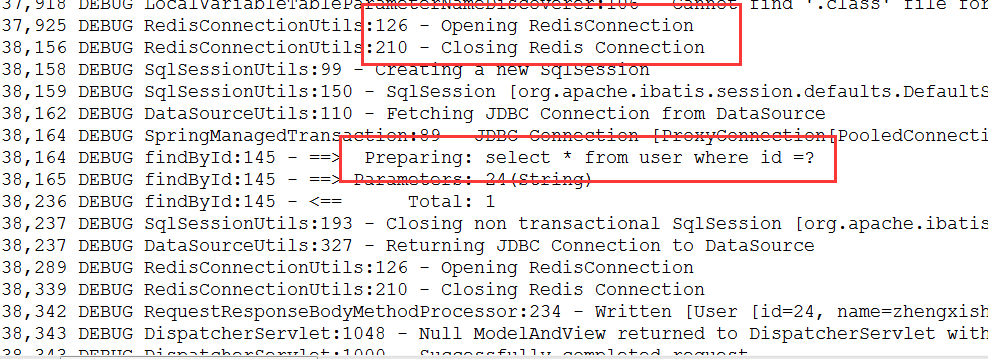springboot jpa操作redis SpringBoot使用Redis快取
SpringBoot使用Redis快取
(1)pom.xml引入jar包,如下:
<dependency>
<groupId>org.springframework.boot</groupId>
<artifactId>spring-boot-starter-data-redis</artifactId>
</dependency>
(2)修改專案啟動類,增加註解@EnableCaching,開啟快取功能,如下:

package springboot;
import org.springframework.boot.SpringApplication;
import org.springframework.boot.autoconfigure.SpringBootApplication;
import org.springframework.cache.annotation.EnableCaching;
import org.springframework.scheduling.annotation.EnableScheduling;
@SpringBootApplication
@EnableScheduling
@EnableCaching
public class SpringbootApplication{
public static void main(String[] args) {
SpringApplication.run(SpringbootApplication.class, args);
}
}
(3)application.properties中配置Redis連線資訊,如下:

# Redis資料庫索引(預設為0) spring.redis.database=0 # Redis伺服器地址 spring.redis.host=172.31.19.222 # Redis伺服器連線埠 spring.redis.port=6379 # Redis伺服器連線密碼(預設為空) spring.redis.password= # 連線池最大連線數(使用負值表示沒有限制) spring.redis.pool.max-active=8 # 連線池最大阻塞等待時間(使用負值表示沒有限制) spring.redis.pool.max-wait=-1 # 連線池中的最大空閒連線 spring.redis.pool.max-idle=8 # 連線池中的最小空閒連線 spring.redis.pool.min-idle=0 # 連線超時時間(毫秒) spring.redis.timeout=0

(4)新建Redis快取配置類RedisConfig,如下:

package springboot.config;
import org.springframework.beans.factory.annotation.Value;
import org.springframework.cache.CacheManager;
import org.springframework.cache.annotation.CachingConfigurerSupport;
import org.springframework.cache.annotation.EnableCaching;
import org.springframework.context.annotation.Bean;
import org.springframework.context.annotation.Configuration;
import org.springframework.data.redis.cache.RedisCacheManager;
import org.springframework.data.redis.connection.RedisConnectionFactory;
import org.springframework.data.redis.core.RedisTemplate;
import org.springframework.data.redis.core.StringRedisTemplate;
import org.springframework.data.redis.serializer.Jackson2JsonRedisSerializer;
import com.fasterxml.jackson.annotation.JsonAutoDetect;
import com.fasterxml.jackson.annotation.PropertyAccessor;
import com.fasterxml.jackson.databind.ObjectMapper;
/**
* Redis快取配置類
* @author szekinwin
*
*/
@Configuration
@EnableCaching
public class RedisConfig extends CachingConfigurerSupport{
@Value("${spring.redis.host}")
private String host;
@Value("${spring.redis.port}")
private int port;
@Value("${spring.redis.timeout}")
private int timeout;
//自定義快取key生成策略
// @Bean
// public KeyGenerator keyGenerator() {
// return new KeyGenerator(){
// @Override
// public Object generate(Object target, java.lang.reflect.Method method, Object... params) {
// StringBuffer sb = new StringBuffer();
// sb.append(target.getClass().getName());
// sb.append(method.getName());
// for(Object obj:params){
// sb.append(obj.toString());
// }
// return sb.toString();
// }
// };
// }
//快取管理器
@Bean
public CacheManager cacheManager(@SuppressWarnings("rawtypes") RedisTemplate redisTemplate) {
RedisCacheManager cacheManager = new RedisCacheManager(redisTemplate);
//設定快取過期時間
cacheManager.setDefaultExpiration(10000);
return cacheManager;
}
@Bean
public RedisTemplate<String, String> redisTemplate(RedisConnectionFactory factory){
StringRedisTemplate template = new StringRedisTemplate(factory);
setSerializer(template);//設定序列化工具
template.afterPropertiesSet();
return template;
}
private void setSerializer(StringRedisTemplate template){
@SuppressWarnings({ "rawtypes", "unchecked" })
Jackson2JsonRedisSerializer jackson2JsonRedisSerializer = new Jackson2JsonRedisSerializer(Object.class);
ObjectMapper om = new ObjectMapper();
om.setVisibility(PropertyAccessor.ALL, JsonAutoDetect.Visibility.ANY);
om.enableDefaultTyping(ObjectMapper.DefaultTyping.NON_FINAL);
jackson2JsonRedisSerializer.setObjectMapper(om);
template.setValueSerializer(jackson2JsonRedisSerializer);
}
}

(5)新建UserMapper,如下:

package springboot.dao;
import org.apache.ibatis.annotations.Delete;
import org.apache.ibatis.annotations.Insert;
import org.apache.ibatis.annotations.Mapper;
import org.apache.ibatis.annotations.Param;
import org.apache.ibatis.annotations.Select;
import org.apache.ibatis.annotations.Update;
import org.springframework.cache.annotation.CacheConfig;
import org.springframework.cache.annotation.CacheEvict;
import org.springframework.cache.annotation.CachePut;
import org.springframework.cache.annotation.Cacheable;
import springboot.domain.User;
@Mapper
@CacheConfig(cacheNames = "users")
public interface UserMapper {
@Insert("insert into user(name,age) values(#{name},#{age})")
int addUser(@Param("name")String name,@Param("age")String age);
@Select("select * from user where id =#{id}")
@Cacheable(key ="#p0")
User findById(@Param("id") String id);
@CachePut(key = "#p0")
@Update("update user set name=#{name} where id=#{id}")
void updataById(@Param("id")String id,@Param("name")String name);
//如果指定為 true,則方法呼叫後將立即清空所有快取
@CacheEvict(key ="#p0",allEntries=true)
@Delete("delete from user where id=#{id}")
void deleteById(@Param("id")String id);
}

@Cacheable將查詢結果快取到redis中,(key="#p0")指定傳入的第一個引數作為redis的key。
@CachePut,指定key,將更新的結果同步到redis中
@CacheEvict,指定key,刪除快取資料,allEntries=true,方法呼叫後將立即清除快取
(6)service層與controller層跟上一篇整合一樣,啟動redis伺服器,redis伺服器的安裝與啟動可以參考之前的部落格,地址如下:
http://www.cnblogs.com/gdpuzxs/p/6623171.html
(7)配置log4j日誌資訊,如下:

## LOG4J配置
log4j.rootCategory=DEBUG,stdout
## 控制檯輸出
log4j.appender.stdout=org.apache.log4j.ConsoleAppender
log4j.appender.stdout.layout=org.apache.log4j.PatternLayout
log4j.appender.stdout.layout.ConversionPattern=%d{yyyy-MM-dd HH:mm:ss,SSS} %5p %c{1}:%L - %m%n

(8)驗證redis快取
首先我們向user表總插入一條資料,資料庫顯示如下:

現在,我們查詢一下user表中id=24的資料,觀擦控制檯輸出的資訊,如下:

通過控制檯輸出資訊我們可以知道,這次執行了資料庫查詢,並開啟了Redis快取查詢結果。接下來我們再次查詢user表中id=24的資料,觀察控制檯,如下:

通過控制檯輸出資訊我們可以知道,這次並沒有執行資料庫查詢,而是從Redis快取中查詢,並返回查詢結果。我們檢視redis中的資訊,如下:

方法finduser方法使用了註解@Cacheable(key="#p0"),即將id作為redis中的key值。當我們更新資料的時候,應該使用@CachePut(key="#p0")進行快取資料的更新,否則將查詢到髒資料。
(1)pom.xml引入jar包,如下:
<dependency>
<groupId>org.springframework.boot</groupId>
<artifactId>spring-boot-starter-data-redis</artifactId>
</dependency>
(2)修改專案啟動類,增加註解@EnableCaching,開啟快取功能,如下:

package springboot;
import org.springframework.boot.SpringApplication;
import org.springframework.boot.autoconfigure.SpringBootApplication;
import org.springframework.cache.annotation.EnableCaching;
import org.springframework.scheduling.annotation.EnableScheduling;
@SpringBootApplication
@EnableScheduling
@EnableCaching
public class SpringbootApplication{
public static void main(String[] args) {
SpringApplication.run(SpringbootApplication.class, args);
}
}

(3)application.properties中配置Redis連線資訊,如下:

# Redis資料庫索引(預設為0) spring.redis.database=0 # Redis伺服器地址 spring.redis.host=172.31.19.222 # Redis伺服器連線埠 spring.redis.port=6379 # Redis伺服器連線密碼(預設為空) spring.redis.password= # 連線池最大連線數(使用負值表示沒有限制) spring.redis.pool.max-active=8 # 連線池最大阻塞等待時間(使用負值表示沒有限制) spring.redis.pool.max-wait=-1 # 連線池中的最大空閒連線 spring.redis.pool.max-idle=8 # 連線池中的最小空閒連線 spring.redis.pool.min-idle=0 # 連線超時時間(毫秒) spring.redis.timeout=0

(4)新建Redis快取配置類RedisConfig,如下:

package springboot.config;
import org.springframework.beans.factory.annotation.Value;
import org.springframework.cache.CacheManager;
import org.springframework.cache.annotation.CachingConfigurerSupport;
import org.springframework.cache.annotation.EnableCaching;
import org.springframework.context.annotation.Bean;
import org.springframework.context.annotation.Configuration;
import org.springframework.data.redis.cache.RedisCacheManager;
import org.springframework.data.redis.connection.RedisConnectionFactory;
import org.springframework.data.redis.core.RedisTemplate;
import org.springframework.data.redis.core.StringRedisTemplate;
import org.springframework.data.redis.serializer.Jackson2JsonRedisSerializer;
import com.fasterxml.jackson.annotation.JsonAutoDetect;
import com.fasterxml.jackson.annotation.PropertyAccessor;
import com.fasterxml.jackson.databind.ObjectMapper;
/**
* Redis快取配置類
* @author szekinwin
*
*/
@Configuration
@EnableCaching
public class RedisConfig extends CachingConfigurerSupport{
@Value("${spring.redis.host}")
private String host;
@Value("${spring.redis.port}")
private int port;
@Value("${spring.redis.timeout}")
private int timeout;
//自定義快取key生成策略
// @Bean
// public KeyGenerator keyGenerator() {
// return new KeyGenerator(){
// @Override
// public Object generate(Object target, java.lang.reflect.Method method, Object... params) {
// StringBuffer sb = new StringBuffer();
// sb.append(target.getClass().getName());
// sb.append(method.getName());
// for(Object obj:params){
// sb.append(obj.toString());
// }
// return sb.toString();
// }
// };
// }
//快取管理器
@Bean
public CacheManager cacheManager(@SuppressWarnings("rawtypes") RedisTemplate redisTemplate) {
RedisCacheManager cacheManager = new RedisCacheManager(redisTemplate);
//設定快取過期時間
cacheManager.setDefaultExpiration(10000);
return cacheManager;
}
@Bean
public RedisTemplate<String, String> redisTemplate(RedisConnectionFactory factory){
StringRedisTemplate template = new StringRedisTemplate(factory);
setSerializer(template);//設定序列化工具
template.afterPropertiesSet();
return template;
}
private void setSerializer(StringRedisTemplate template){
@SuppressWarnings({ "rawtypes", "unchecked" })
Jackson2JsonRedisSerializer jackson2JsonRedisSerializer = new Jackson2JsonRedisSerializer(Object.class);
ObjectMapper om = new ObjectMapper();
om.setVisibility(PropertyAccessor.ALL, JsonAutoDetect.Visibility.ANY);
om.enableDefaultTyping(ObjectMapper.DefaultTyping.NON_FINAL);
jackson2JsonRedisSerializer.setObjectMapper(om);
template.setValueSerializer(jackson2JsonRedisSerializer);
}
}

(5)新建UserMapper,如下:

package springboot.dao;
import org.apache.ibatis.annotations.Delete;
import org.apache.ibatis.annotations.Insert;
import org.apache.ibatis.annotations.Mapper;
import org.apache.ibatis.annotations.Param;
import org.apache.ibatis.annotations.Select;
import org.apache.ibatis.annotations.Update;
import org.springframework.cache.annotation.CacheConfig;
import org.springframework.cache.annotation.CacheEvict;
import org.springframework.cache.annotation.CachePut;
import org.springframework.cache.annotation.Cacheable;
import springboot.domain.User;
@Mapper
@CacheConfig(cacheNames = "users")
public interface UserMapper {
@Insert("insert into user(name,age) values(#{name},#{age})")
int addUser(@Param("name")String name,@Param("age")String age);
@Select("select * from user where id =#{id}")
@Cacheable(key ="#p0")
User findById(@Param("id") String id);
@CachePut(key = "#p0")
@Update("update user set name=#{name} where id=#{id}")
void updataById(@Param("id")String id,@Param("name")String name);
//如果指定為 true,則方法呼叫後將立即清空所有快取
@CacheEvict(key ="#p0",allEntries=true)
@Delete("delete from user where id=#{id}")
void deleteById(@Param("id")String id);
}

@Cacheable將查詢結果快取到redis中,(key="#p0")指定傳入的第一個引數作為redis的key。
@CachePut,指定key,將更新的結果同步到redis中
@CacheEvict,指定key,刪除快取資料,allEntries=true,方法呼叫後將立即清除快取
(6)service層與controller層跟上一篇整合一樣,啟動redis伺服器,redis伺服器的安裝與啟動可以參考之前的部落格,地址如下:
http://www.cnblogs.com/gdpuzxs/p/6623171.html
(7)配置log4j日誌資訊,如下:

## LOG4J配置
log4j.rootCategory=DEBUG,stdout
## 控制檯輸出
log4j.appender.stdout=org.apache.log4j.ConsoleAppender
log4j.appender.stdout.layout=org.apache.log4j.PatternLayout
log4j.appender.stdout.layout.ConversionPattern=%d{yyyy-MM-dd HH:mm:ss,SSS} %5p %c{1}:%L - %m%n

(8)驗證redis快取
首先我們向user表總插入一條資料,資料庫顯示如下:

現在,我們查詢一下user表中id=24的資料,觀擦控制檯輸出的資訊,如下:

通過控制檯輸出資訊我們可以知道,這次執行了資料庫查詢,並開啟了Redis快取查詢結果。接下來我們再次查詢user表中id=24的資料,觀察控制檯,如下:

通過控制檯輸出資訊我們可以知道,這次並沒有執行資料庫查詢,而是從Redis快取中查詢,並返回查詢結果。我們檢視redis中的資訊,如下:

方法finduser方法使用了註解@Cacheable(key="#p0"),即將id作為redis中的key值。當我們更新資料的時候,應該使用@CachePut(key="#p0")進行快取資料的更新,否則將查詢到髒資料。
